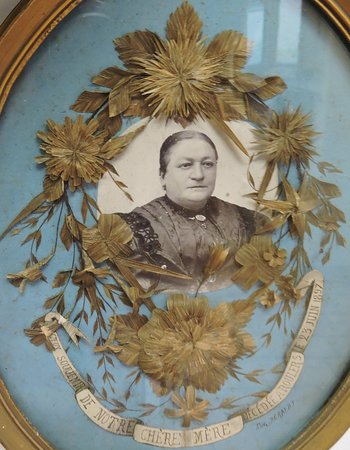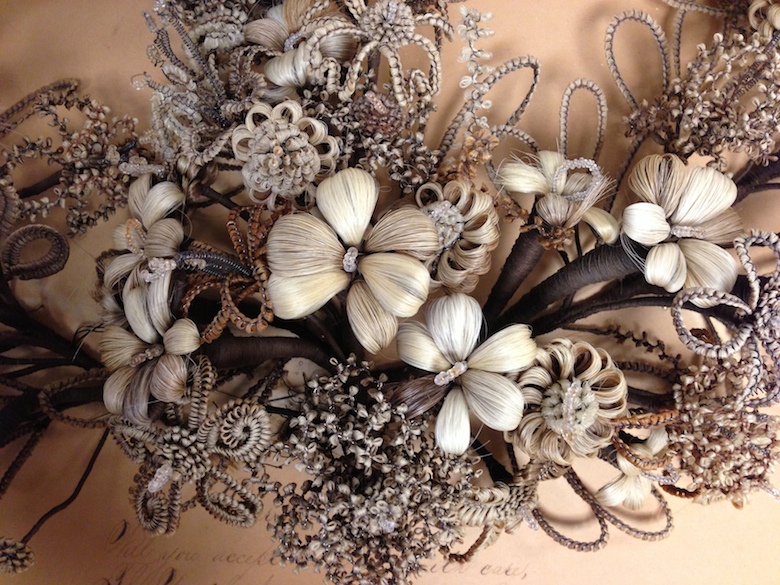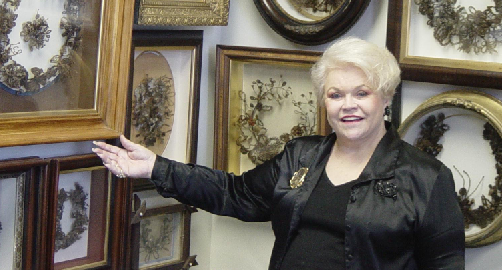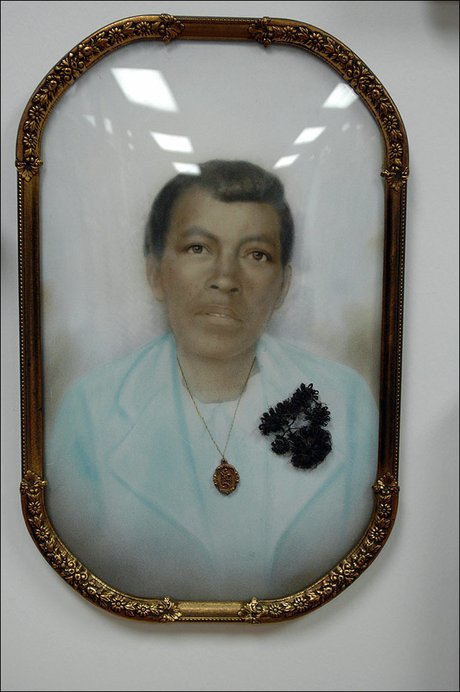The docent at Leila’s museum stresses to me that the collection I’m looking at isn’t about death, but her words are less than convincing. For one thing, I suspect that all collections are about death. Collectors, by nature, unite formerly unrelated objects. They rearrange them, explain their context and give them new contexts by linking them to the life of the person who amassed them Then they’re displayed until the collection become a piece of a person’s identity: my Aunt Rose Mary and her Irish Wolfhounds, Jay Leno and his cars, Eli Broad and his art. But unlike their owners, the collections don’t die. To collect is to illustrate your life in objects, curating your legacy, that little immortal piece of our identity that’s left behind. But I don’t think that’s what the docent is referring to. If Leila’s museum seems to be about death, it’s because the hair of the dead covers every available wall. Leila collects art that’s made of human hair and displays it to the public at the museum bearing her name in Independence, Missouri.
“A lot of people think hair art is morbid but it’s really about love”, the docent on duty insists as I take in a hundred or so mousey-brown wreaths and crosses occupying the front room. She can’t see my eyebrow arch because my gaze has settled on a funeral wreath of hair and the words MEL 1877, also made of hair, beneath it. The Victorians had strange ways of showing they cared.
The majority of Leila’s collection is from the Victorian period which stretched from 1837 to 1901. Like bustled black dresses or silver lachrymatory used to bottle tears (also on display in Leila’s vestibule), hair jewelry was part of the pageant of mourning in the mid to late 19thcentury. Hair was sometimes taken from the dead, wrapped around wire and worked into filigree sculptures then preserved under glass. In other cases the hair of the deceased was used to make jewelry which was considered modest enough to wear during mourning when most pieces would have to be retired for a year and a day. This funereal context is how we think of hairwork today if we think of it at all, but the docent is correct, most of it wasn’t so grim. Families tracked genealogy through horseshoe-shaped wreaths and documented each relation with labeled flowers made from their hair. Women exchanged locks as tokens of friendship. Weddings were commemorated by weaving the couple’s hair together or by a wife making her husband a fob or ring of her hair to keep with him.
There are examples of all of these types of hairwork at Leila’s museum. The museum itself is housed in a generic 70s commercial building that looks like it ought to be a Goodwill or a used car dealership. The mirrored windows make it look vacant from the outside and inside the fluorescent lights add to the funeral pall which the docent is eager to cast off. She tells me about the museum’s namesake: Leila Cohoon, the retired beautician who became fascinated with human hair art when she bought her first piece at an antiques shop in 1956. She’s been exhibiting her collection to the public since 1986. Leila is alive and well but she isn’t at the museum today except in the way that she always is—in a frame near the door where she’s shaped clippings from her platinum bouffant into a bedazzled spray of daisies. The docent tells me that Leila used Elmer’s glue to hold the strands together but the Victorians probably would have used egg whites or sugar water. Of the thirty techniques that Leila has identified for making hair art, she practices twenty-six.
Despite my tour guide’s initial protestations and the liveliness of Leila’s daisies, the specter of death is always near, even when the hair pieces weren’t created for mourning. One family tree lists the marriage and death dates for all but one daughter. “So we know who made this piece” the docent points out as I imagine this last daughter, never married, documenting the death of her entire family. Another family piece is simpler—children’s hair arranged in ringlets by their mother. Each child has multiple entries so you can see their baby-fine hair get coarser and darker over time, except for the youngest who only has one entry at three weeks. Freud had a theory about collecting. He saw it as a reaction to the separation anxiety and loss of control we felt as children when our bodily fluids came out of us and were taken away. In a way it reminds me of this mother who collected her children, including the lost child, which were once a part of her. Freud’s focus on bodily functions seems crude but the corporeality seems right. It’s easy to see how small pieces of people could be cherished and collected in an era when death came too soon and even young people amassed collections of dead friends. This difficult truth turns up unexpectedly in a wreath made of brightly dyed white horsehair—an unexpected rainbow in a sea of chestnut brown and dishwater blonde. The docent notes that white hair art is almost always from horses— many in the Victorian era never lived to go gray.
Implied tragedy is everywhere and carries over to a wall that features the framed hair of dead celebrities, mostly bought by Leila online. There are barely visible strands of Marilyn Monroe, Elvis, Michael Jackson and Ronald Regan—all usual, and in their own ways, tragic subjects of modern veneration. All people whom so many wanted a piece of, though usually not so literally. Memories of the celebrities are sparked whenever someone sees this little piece of them so their presence is always felt here. In this way they resemble some of the earliest body part collections—the royal relic collections of the Middle Ages.
 There’s a concept in Catholicism that says that the body and soul of a saint (a Catholic kind of celebrity) are inextricable from each other so the presence of a saint is stronger at the place where their body, or at least a piece of it, rests. Because of this, the bodies of saints were divided into smaller and smaller pieces to maximize their power and medieval kings set about collecting them. As they added new pieces, they were also putting together a kind of cabinet—a team of powerful miracle workers they could call upon since the remains of these saints were forever tied to their souls in heaven. Like other collectors, the gathering of objects soothed their fear of death. These collections and the legacy of the kings who collected them, would live on with the added hope that the saints they hoarded would welcome them into the afterlife.
There’s a concept in Catholicism that says that the body and soul of a saint (a Catholic kind of celebrity) are inextricable from each other so the presence of a saint is stronger at the place where their body, or at least a piece of it, rests. Because of this, the bodies of saints were divided into smaller and smaller pieces to maximize their power and medieval kings set about collecting them. As they added new pieces, they were also putting together a kind of cabinet—a team of powerful miracle workers they could call upon since the remains of these saints were forever tied to their souls in heaven. Like other collectors, the gathering of objects soothed their fear of death. These collections and the legacy of the kings who collected them, would live on with the added hope that the saints they hoarded would welcome them into the afterlife.
Though she isn’t Catholic, Leila keeps a number of reliquaries with the hair of saints. One of them contains what Leila believes is a hair from the head of St. Anne. Another hair allegedly belongs to the Virgin Mary. That one is a highlight of the museum, displayed with a red wax seal and a mysterious story about its acquisition from an unnamed antiquities dealer in Belgium.
As I turn from the reliquaries, I notice a hair wreath with a crumbling taxidermied bird perched on top. My tour guide tells me that what makes the museum possible is that unlike the bird, hair is curiously incorrupt. According to her, it doesn’t decay. That isn’t quite right, hair decays like all organic material, but it does disintegrate at a much slower rate than flesh. Still, she says even Mary’s hair will look as fresh in another thousand years as it does today and she very well could be right. But what’s curious is that though hair may survive, like collections long after the collector, death is also intrinsic to hair. By the time you can see it on your body it’s no longer alive. This is part of what makes it such an unsettling medium: that which is dead, that which should be buried, is not only visible but on display in hair art.
The docent acknowledges that hair art is not for everyone. It makes some people queasy and it’s fairly common to see husbands holding a purse in the lobby while their wives take a tour of the museum. But I look at a display of little hair rings and lovers’ lockets again. I wonder if what unnerves these staid Midwestern men isn’t the medium, but the message. These pieces represent a raw sentimentality untouched by cynicism. They’re a refusal to part with another. Hair art speaks to our most vulnerable feelings: love and grief, all in the form of a sculpture or the braided bands that were made to be worn around the upper arm—literally on one’s sleeve.




